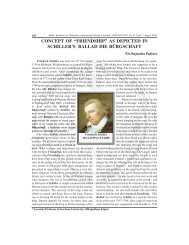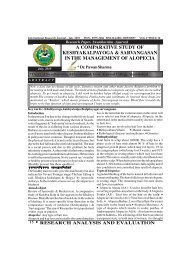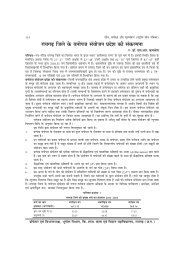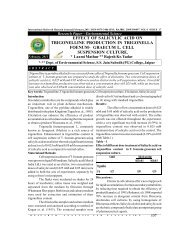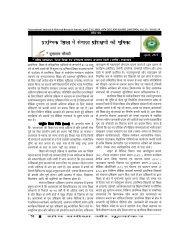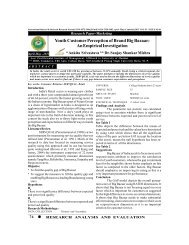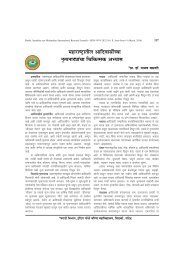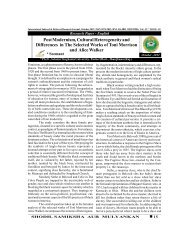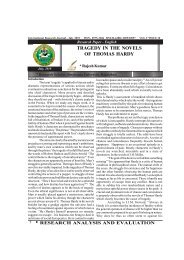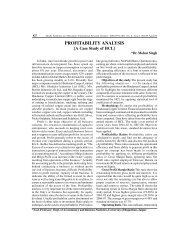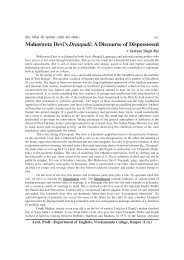hidden apartheid: an evaluation of depressed classes in social ...
hidden apartheid: an evaluation of depressed classes in social ...
hidden apartheid: an evaluation of depressed classes in social ...
You also want an ePaper? Increase the reach of your titles
YUMPU automatically turns print PDFs into web optimized ePapers that Google loves.
International Referred Research Journal, October,2010.ISSN- 0974-2832VoL.II *ISSUE-21<br />
Research Paper—History<br />
Introduction<br />
The Indi<strong>an</strong> societal stratification expla<strong>in</strong>s<br />
the <strong>social</strong> restrictions <strong>in</strong> which <strong>social</strong> modules are<br />
def<strong>in</strong>ed by thous<strong>an</strong>ds <strong>of</strong> endogamous hereditary<br />
groups that is <strong>of</strong>ten termed as jatis or castes. With<strong>in</strong> a<br />
jati, there subsist exogamous groups known as gotras<br />
which expla<strong>in</strong>s the <strong>an</strong>cestry <strong>of</strong> <strong>an</strong> <strong>in</strong>dividual. There is<br />
no universally accepted speculation about the<br />
derivation <strong>of</strong> the Indi<strong>an</strong> <strong>social</strong> ladder. The Indi<strong>an</strong> <strong>classes</strong><br />
are <strong>an</strong>alogous to the <strong>an</strong>cient Ir<strong>an</strong>i<strong>an</strong> <strong>classes</strong><br />
(pistras), where<strong>in</strong> the priests are Brahm<strong>in</strong>s, the warriors<br />
are Kshatriya, the merch<strong>an</strong>ts are Vastriya, <strong>an</strong>d the<br />
artis<strong>an</strong>s are Huiti. Accord<strong>in</strong>g to the <strong>an</strong>cient H<strong>in</strong>du<br />
scriptures, there are four “varnas”. The Bhagavad<br />
Gita op<strong>in</strong>es that varnas are determ<strong>in</strong>ed<br />
by Guna (positive behavioral patterns) <strong>an</strong>d Karma (true<br />
efforts). M<strong>an</strong>usmriti <strong>an</strong>d a few other scriptures cite four<br />
varnas viz. the Brahm<strong>in</strong>s (<strong>in</strong>tellectuals), the Kshatriyas<br />
(battle riders), the Vaishyas (traders) <strong>an</strong>d Shudras<br />
(service providers). This theoretical scheme postulated<br />
Varna categories as ideals <strong>an</strong>d expla<strong>in</strong>ed the authenticity<br />
<strong>of</strong> thous<strong>an</strong>ds <strong>of</strong> endogamous Jatis widespreaded <strong>in</strong> the<br />
countryside. All those <strong>in</strong>clud<strong>in</strong>g foreigners, tribals <strong>an</strong>d<br />
nomads, who did not subscribe to the norms <strong>of</strong> the H<strong>in</strong>du<br />
culture were attributed as contagious <strong>an</strong>d untouchables.<br />
Methodology<br />
The study has been illum<strong>in</strong>ated through literary sources<br />
<strong>of</strong> colonial era. The demographic datas <strong>of</strong> the census <strong>of</strong><br />
1891 expla<strong>in</strong>s major caste groups which are further<br />
classified <strong>in</strong> cl<strong>an</strong>s or jatis. Ameliorative measures done<br />
<strong>in</strong> pre <strong>in</strong>dependence era are based on literary sources<br />
while post <strong>in</strong>dependential reformative measures have<br />
been traced from the Constitution <strong>of</strong> India, census <strong>of</strong><br />
2001 <strong>an</strong>d reports furnished by ST & SC Commission.<br />
46<br />
HIDDENAPARTHEID: AN EVALUATION OF<br />
DEPRESSED CLASSES IN SOCIAL<br />
CONFIGURATION<br />
* Dr. Hareet kumar meena<br />
* H.O.D, Dept. <strong>of</strong> History Jaimenash College Jamuaramgarh, Jaipur<br />
A B S T R A C T<br />
October, 2010<br />
The rationale <strong>of</strong> this research paper is to emphasize various rudiments that potray the ideas <strong>an</strong>d ideology <strong>of</strong> discrim<strong>in</strong>ation<br />
or <strong>social</strong> <strong>in</strong>equality <strong>in</strong> Indi<strong>an</strong> societal milieu. Precisely, <strong>in</strong>equality is <strong>of</strong> two types: first one is natural (physical<br />
misalignment) <strong>an</strong>d the later one is engraved by society, which <strong>in</strong> historical epochs has been termed as “Untouchables”<br />
or “Depressed <strong>classes</strong>”. The paper highlights the conceptuality, <strong>in</strong>stigation <strong>an</strong>d exp<strong>an</strong>sion <strong>of</strong> <strong>social</strong> segregation s<strong>in</strong>ce<br />
Vedic cultural phase (Varna system) upto the catalog<strong>in</strong>g <strong>of</strong> Harij<strong>an</strong>s, a more moderate design co<strong>in</strong>ed by Mahatma G<strong>an</strong>dhi.<br />
Orig<strong>in</strong>ation <strong>an</strong>d Humiliation <strong>of</strong> Depressed Classes<br />
The utter<strong>an</strong>ce <strong>of</strong> Depressed Classes belongs to Marathi<br />
tongue that me<strong>an</strong>s suppressed, crushed, or broken <strong>in</strong>to<br />
pieces. It was earliest used by Jyotirao Phule <strong>in</strong> the<br />
n<strong>in</strong>eteenth century, <strong>in</strong> the context <strong>of</strong> the oppression<br />
faced by the lowest <strong>social</strong> strata. Accord<strong>in</strong>g to Victor<br />
Premasagar, the term expresses “weakness, poverty<br />
<strong>an</strong>d humiliation at the h<strong>an</strong>ds <strong>of</strong> the upper castes <strong>in</strong> the<br />
Indi<strong>an</strong> society.” Moh<strong>an</strong>das G<strong>an</strong>dhi co<strong>in</strong>ed the<br />
word Harij<strong>an</strong>, tr<strong>an</strong>slated roughly as “Children <strong>of</strong> God”,<br />
to recognize the Depressed Classes. In the locale <strong>of</strong><br />
traditional H<strong>in</strong>du society, the status <strong>of</strong> Depressed<br />
Classes has frequently been historically associated<br />
with occupations regarded as ritually impure viz.<br />
leatherwork, butcher<strong>in</strong>g, or removal <strong>of</strong> rubbish <strong>an</strong>d<br />
<strong>an</strong>imal carcasses. Engag<strong>in</strong>g <strong>in</strong> these activities was<br />
measured to be pollut<strong>in</strong>g to the <strong>in</strong>dividual <strong>an</strong>d this<br />
pollution was considered contagious. As a result,<br />
Depressed Classes were generally segregated <strong>an</strong>d<br />
b<strong>an</strong>ned from full participation <strong>in</strong> H<strong>in</strong>du <strong>social</strong> life. For<br />
example, they could not enter a temple nor a school, <strong>an</strong>d<br />
were required to stay outside the village. In 18th century,<br />
the castes did not represent a rigid description <strong>of</strong> the<br />
occupation or the <strong>social</strong> status <strong>of</strong> a group. S<strong>in</strong>ce British<br />
culture was alienated by class, therefore they attempted<br />
to equate the Indi<strong>an</strong> <strong>social</strong> arr<strong>an</strong>gement to their own<br />
<strong>social</strong> class design.In 19th & 20th century the Harij<strong>an</strong>s,<br />
or the populace outside the <strong>social</strong> structure, had the<br />
lowest <strong>social</strong> grade. The Harij<strong>an</strong>s, earlier referred to as<br />
untouchables worked <strong>in</strong> unhealthy, unpleas<strong>an</strong>t or<br />
pollut<strong>in</strong>g jobs. They suffered from <strong>social</strong> segregation<br />
<strong>an</strong>d restrictions, <strong>in</strong> addition to extreme poverty. They<br />
were not allowed temple worship nor water from the<br />
same sources. Persons <strong>of</strong> higher castes would not<br />
<strong>in</strong>teract with them. If somehow a member <strong>of</strong> a higher<br />
caste came <strong>in</strong>to physical or <strong>social</strong> contact with <strong>an</strong><br />
' k k s / k l e h { k k v k S j e wY ; k a d u
International Referred Research Journal, October,2010. ISSN- 0974-2832VoL.II *ISSUE-21<br />
untouchable, the member <strong>of</strong> the higher caste was defiled, H<strong>in</strong>duism. The first temple to welcome Depressed<br />
<strong>an</strong>d had to bathe thoroughly to purge him or herself <strong>of</strong> Classes was the Laxm<strong>in</strong>aray<strong>an</strong>Temple <strong>in</strong> Wardha <strong>in</strong> the<br />
the impurity. Social discrim<strong>in</strong>ation developed even year 1928.The budge was spearheaded by Jamnalal<br />
among the Harij<strong>an</strong>s. Sub-castes among Harij<strong>an</strong>s, Bajaj. Another example was the Temple Entry<br />
like dhobi (waserm<strong>an</strong>), nai (barber) etc. would not Proclamation issued by the last Maharaja <strong>of</strong><br />
<strong>in</strong>teract with lower-order Bh<strong>an</strong>gis, who were described Trav<strong>an</strong>core <strong>in</strong> the Indi<strong>an</strong> state <strong>of</strong> Kerala <strong>in</strong> the year<br />
S.No Caste Group Example Population<br />
1. Cultivators Maurya, Kurmi, Mali, Lodha, Kushwaha 20%<br />
2. Village Menials Chamar, Dosadh, Dom 13%<br />
3. Military Jat, Rajput, Nairs, Maratha 12%<br />
4. Artis<strong>an</strong>s Lohar, Sunar, Julaha 12%<br />
5. Pastoral Ahir, Gaderia, Dh<strong>an</strong>gar 7%<br />
6. Forest tribes S<strong>an</strong>thal, Gond, Bhil 7%<br />
7. Pr<strong>of</strong>essionals Namboothiri, Brahmbhatt, Kayasth 6%<br />
8. Services Nai, Dhobi, K<strong>an</strong>doi 6%<br />
9. Merch<strong>an</strong>ts Agrawal, Khatri, Balija, Barnwal 5%<br />
10. Laborers Musahar, Bagdi, Bawari 3%<br />
11. Fishers Kahar, Mallah 3%<br />
12. Other pr<strong>of</strong>essionals Vaidya, Mirasi, Bh<strong>an</strong>d 2%<br />
13. Vagr<strong>an</strong>ts Waddar, Nat, Beldar 1%<br />
as “outcasts even among outcastes”.<br />
Reformation <strong>of</strong> Depressed Classes <strong>in</strong> Pre-<br />
Independence era<br />
Gautama Buddha <strong>an</strong>d Mahaveer Swami, the founders<br />
<strong>of</strong> Buddhism <strong>an</strong>d Ja<strong>in</strong>ism respectively, were perhaps the<br />
<strong>in</strong>itial opponents <strong>of</strong> <strong>an</strong>y sort <strong>of</strong> caste configuration.<br />
Some other movements <strong>in</strong> H<strong>in</strong>duism have also welcomed<br />
lower-castes <strong>in</strong>to their fold, the earliest be<strong>in</strong>g the Bhakti<br />
movements <strong>of</strong> the medieval period. M<strong>an</strong>y bhakti sa<strong>in</strong>ts<br />
such as Kabir, N<strong>an</strong>ak <strong>an</strong>d Cait<strong>an</strong>ya rejected all castebased<br />
discrim<strong>in</strong>ation <strong>an</strong>d accepted disciples from all<br />
the castes. N<strong>an</strong>d<strong>an</strong>ar, a low-caste H<strong>in</strong>du cleric, also<br />
rejected casteism <strong>an</strong>d accepted Depressed Classes.In<br />
19th Century, the Brahmo Samaj under Raja Ram Moh<strong>an</strong><br />
Roy, enthusiastically campaigned aga<strong>in</strong>st<br />
untouchability <strong>an</strong>d Casteism. The Arya Samaj founded<br />
by Swami Day<strong>an</strong><strong>an</strong>d renounced discrim<strong>in</strong>ation aga<strong>in</strong>st<br />
DepressedClasses.Shri Ramakrishna Paramahamsa <strong>an</strong>d<br />
his utmost partis<strong>an</strong> Swami Vivek<strong>an</strong><strong>an</strong>da founded<br />
the Ramakrishna Mission that participated <strong>in</strong> the<br />
em<strong>an</strong>cipation <strong>of</strong> Depressed Classes.Upper caste<br />
H<strong>in</strong>dus,such as M<strong>an</strong>nathu Padm<strong>an</strong>abh<strong>an</strong> participated<br />
<strong>in</strong> movements to abolish Untouchability<br />
through open<strong>in</strong>g his temple for Depressed Classes for<br />
worship. Naray<strong>an</strong>a Guru, a pious H<strong>in</strong>du <strong>an</strong>d <strong>an</strong> authority<br />
on the Vedas, criticized casteism <strong>an</strong>d campaigned for<br />
the rights <strong>of</strong> lower-caste H<strong>in</strong>dus with<strong>in</strong> the context <strong>of</strong><br />
R E F E R E N C E<br />
1936. The Maharaja proclaimed that<br />
“outcastes should not be denied the<br />
consolations <strong>an</strong>d the solace <strong>of</strong><br />
the H<strong>in</strong>du faith”.B. R. Ambedkar,<br />
born <strong>in</strong> H<strong>in</strong>du Depressed Class<br />
community, was a weighty censor <strong>of</strong><br />
casteism. He pioneered the Neo-<br />
Buddhist lobby <strong>in</strong> India, <strong>an</strong>d asked<br />
his followers to leave distorted<br />
H<strong>in</strong>duism. Jawaharlal Nehru also<br />
spread <strong>in</strong>formation about the dire<br />
need to eradicate untouchability for<br />
overall <strong>social</strong> adv<strong>an</strong>cement that will ultimately escort to<br />
National development. Ameliorative measures <strong>in</strong><br />
Post-Independence era<br />
Until the mid-1970s, the politics <strong>of</strong> <strong>in</strong>dependent India<br />
was pr<strong>in</strong>cipally dom<strong>in</strong>ated by economic issues <strong>an</strong>d<br />
questions <strong>of</strong> corruption. In 1980, the commission’s<br />
testimony affirmed the practice under Indi<strong>an</strong> law<br />
whereby members <strong>of</strong> lower castes were given exclusive<br />
admission to a certa<strong>in</strong> portion <strong>of</strong> government jobs.In<br />
1989,when V.P. S<strong>in</strong>gh Government tried toexecute the<br />
recommendations <strong>of</strong> M<strong>an</strong>dal Commission enormous<br />
protests were held <strong>in</strong> the country. M<strong>an</strong>y alleged that the<br />
politici<strong>an</strong>s were try<strong>in</strong>g to encash caste-based<br />
reservations for solely pragmatic electoral purposes.<br />
Although Indi<strong>an</strong> constitution sought to abolish cast<br />
discrim<strong>in</strong>ation <strong>an</strong>d the practice <strong>of</strong> untouchability, the caste<br />
system rema<strong>in</strong>s severely deep-rooted <strong>in</strong> H<strong>in</strong>du culture<br />
<strong>an</strong>d is still widespread, especially <strong>in</strong> rural depots.<br />
Suggestions<br />
Historically, the Depressed <strong>classes</strong> limited themselves<br />
<strong>in</strong> isolated areas, therefore for their climb they need a<br />
psychological environment for full <strong>social</strong> m<strong>in</strong>gl<strong>in</strong>g.<br />
Constitutional bodies guard their <strong>in</strong>terest but there is<br />
a greater need to ch<strong>an</strong>ge the <strong>social</strong> outlook. Moreover,<br />
the <strong>in</strong>dividuals related to this <strong>social</strong> stratification have<br />
to prove themselves on political <strong>an</strong>d economic fronts.<br />
1. Gov<strong>in</strong>d Sadashiv Ghurye (1980), The Scheduled Tribes <strong>of</strong> India, Tr<strong>an</strong>saction Publishers. 2. New Book: Anthropology <strong>of</strong><br />
Primitive Tribes <strong>in</strong> India. 3.Edw<strong>in</strong> Bry<strong>an</strong>t <strong>an</strong>d Laurie L. Patton (2005), The Indo-Ary<strong>an</strong> Controversy, Routledge. 4. Ludwig<br />
Gumplowicz <strong>an</strong>d Irv<strong>in</strong>g Louis Horowitz (1980), Outl<strong>in</strong>es <strong>of</strong> Sociology, Tr<strong>an</strong>saction Publishers.5. Spencer Wells (2002), The<br />
Journey <strong>of</strong> M<strong>an</strong>: A Genetic Odyssey, Pr<strong>in</strong>ceton University Press.6. Moh<strong>an</strong>das.K. G<strong>an</strong>dhi (1968), The Selected Works <strong>of</strong><br />
Mahatma G<strong>an</strong>dhi , Navjiv<strong>an</strong> Publish<strong>in</strong>g House. 7. Lok Sabha Debates ser.10 Jun 41-42 1995 v.42 no.41-42, Lok Sabha Secretariat,<br />
Parliament <strong>of</strong> India.<br />
S H O D H S A M I K S H A A U R M U L Y A N K A N 47



